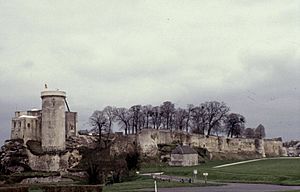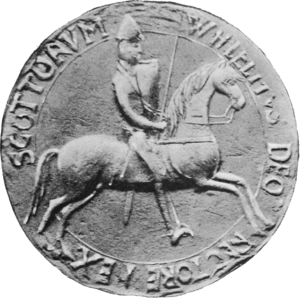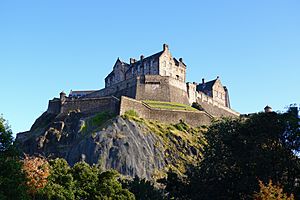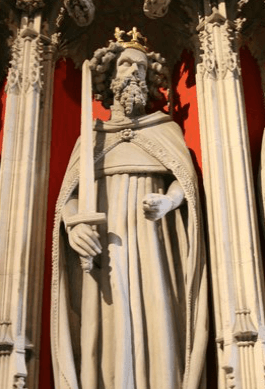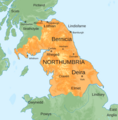Treaty of Falaise facts for kids
The Treaty of Falaise was a written agreement signed in December 1174. It was forced upon William I, the King of Scots, by Henry II, the King of England. William had been captured by Henry's forces.
This treaty made Scotland officially under England's control for the first time. It changed how the Scottish king, nobles, and church leaders related to the English king. The treaty also gave control of important Scottish castles like Roxburgh, Berwick, Jedburgh, Edinburgh, and Stirling to English soldiers. Before this, the King of Scots was supreme, but now England held the highest power in Scotland.
For the next 15 years, William had to follow Henry's rules. For example, he needed Henry's permission to stop local uprisings in Scotland. This made William feel humiliated and caused problems for him at home. Henry even chose William's wife for him.
The treaty ended in 1189. King Richard I, Henry's son, became king and was busy preparing for the Third Crusade. William offered him a large sum of money (10,000 marks). Richard was kinder to William than his father had been. He created a new agreement called the Quitclaim of Canterbury. This new document completely cancelled the Treaty of Falaise. It gave Scotland its independence back, returning to the older, less strict ways of Scottish and English kings showing loyalty to each other, instead of Scotland being directly controlled by England.
Contents
Why the Treaty Happened
The Northumbrian Land Dispute
To understand why William was captured, we need to look at the land called Northumbria. The trouble started in 1157. Henry II took away some lands and titles from William's brother, Malcolm IV, who was then King of Scots. Their grandfather, David I, had gained these lands from King Stephen in 1139.
The border between northern England and southern Scotland was often unclear. It changed depending on how powerful the Scottish and English kings were. During a time of civil war in England, David I invaded northern England. He believed Northumbria and Cumberland belonged to him through his late wife. In 1139, he secured Scottish control of these border lands, including the Earldom of Northumbria for his son, Henry. For Scotland, these lands were now seen as theirs forever. However, King Stephen kept control of two castles in Northumbria, Bamburgh and Newcastle. This meant the Northumbrian question could still cause problems later.
William's Attempts to Reclaim Land
William became King of Scots in 1164. He immediately tried to get back the Earldom of Northumbria, which he felt was his rightful inheritance. He tried to take advantage of Henry II being busy elsewhere. In 1166, William joined Henry in a military campaign in Normandy, hoping to gain favor. But he returned to Scotland empty-handed.
Henry II became angry if anyone spoke well of William. This showed their relationship was getting worse. William even sent messages to King Louis VII of France in 1168, when England and France were fighting. But nothing came of it. William tried again in 1170, meeting Henry at Windsor, but was refused. However, as Earl of Huntingdon, he had to show loyalty to Young Henry, who was now crowned as the future king of England.
William Joins the Fight
In 1173, three of Henry II's sons – Young Henry, Richard, and Geoffrey – along with his wife, Queen Eleanor, and many nobles, started a rebellion against him. They were helped by King Louis VII of France. William saw this as another chance to get Northumbria back.
Young Henry and Louis VII promised William that he would get the lands his ancestors once held, including Northumbria, Westmoreland, and Cumberland. William first offered Henry II 1,000 knights and 30,000 soldiers if Henry would give him Northumbria. Henry refused again. So, William joined the rebels and invaded northern England.
On July 13, 1174, while leading small raids in Northumbria, William was caught by surprise near Alnwick. He had only a few knights with him. When he saw the English approaching, William bravely charged, shouting, "We shall now see who will act the part of a good knight!" He fought his way through the enemy until his horse was killed. He became trapped and had to surrender to Ranulph de Glanvill.
William was taken to Newcastle, then to Richmond, to await Henry's decision. On July 26, Henry had William brought to him at Northampton. William was tied under a horse's belly, a very shameful way to treat a king. This humiliating journey was just the beginning for William.
He was eventually taken to the castle in Falaise, Normandy, where he waited for the rebellion to end. The agreement was written while William was a prisoner in Falaise. It was officially issued at Valognes on December 8, 1174. Henry then held a public ceremony in York on August 10, 1175. William signed the document in front of his brother, David, and many Scottish nobles. The Treaty was read aloud for everyone to hear.
Key Points of the Treaty of Falaise
The Treaty of Falaise made it clear that the King of Scots was now a "liegeman" (a loyal servant) of the King of England for Scotland and all his other lands. This meant William had to swear loyalty to Henry II. He also had to swear loyalty to Henry's son, Young Henry, who was set to become the next king.
The treaty also said that all Scottish bishops, abbots, and other church leaders had to swear loyalty to Henry II and his son. It stated that the Scottish Church should be under the English Church, as it had been in the past.
Scottish nobles and other important men who held land from the King of Scots also had to swear loyalty to Henry II. Their heirs would also have to do the same.
The treaty had rules about criminals. If someone committed a crime in England and fled to Scotland, William was not allowed to protect them unless they agreed to face justice in England. The same applied if a Scottish criminal fled to England.
To make sure William kept his promises, he had to give Henry II control of five important Scottish castles: Roxburgh, Berwick, Jedburgh, Edinburgh, and Stirling. William also had to pay for the soldiers guarding these castles. As a further guarantee, William had to give his brother, David, and several important Scottish earls and barons as hostages to Henry II. Once the castles were handed over, William and David were released. The other nobles were released after they provided their own hostages, usually their sons or closest relatives.
The treaty also stated that any Scottish nobles or church leaders who were not present when the treaty was made had to swear the same loyalty and provide hostages if Henry II demanded it. If William ever broke his promise of loyalty, the Scottish bishops and nobles agreed to side with Henry II against William. The bishops would even place Scotland under a church ban until William returned to his loyalty to Henry.
What Happened After the Treaty
After the treaty, William faced many challenges in Scotland because his power was weakened. In Galloway, old conflicts resurfaced, and William had to ask Henry's advice before he could try to regain control. In Moray and Ross, some nobles were angry and looked for new leaders, like Donald MacWilliam, who claimed to be a descendant of an earlier Scottish king.
William visited Henry's court about eight times in ten years. His weakened position at home and the shame of having Scottish heirs held by Henry caused a lot of unhappiness.
As William's overlord, Henry also had the right to choose William's wife. William first asked for Henry's granddaughter, Matilda of Saxony, but Henry refused. In 1186, Henry chose Ermengarde, a distant relative of his, but the daughter of a less important noble. As a wedding gift, Henry gave Edinburgh Castle back to William. William also got back his title as Earl of Huntingdon (which he immediately gave to his brother David). These small gains, along with William's continued loyalty, showed that Henry was starting to focus more on threats from France than from Scotland.
For Henry, the Treaty was another success after putting down the rebellion. He had already brought his rebellious sons back under control and imprisoned his wife, Queen Eleanor. Even though he now had direct control over Scotland, Henry didn't often need to interfere in Scottish affairs. There's only one record of a Scot asking Henry for help. This was Abbot Archibald of Dunfermline, who sought Henry's protection from English soldiers stationed near Edinburgh, not because of anything William had done. Henry also used William's capture to his advantage. It happened right after Henry had publicly apologized at Thomas Becket’s tomb for Becket's murder. Henry claimed William's capture was a sign from God, showing divine support for England against the Scots, the French, and his own children.
The Treaty Ends
Scotland Regains Freedom
When Henry II died in 1189, his son Richard I became king. William visited Richard soon after his coronation. Richard was more interested in going on the Third Crusade and was friendlier to William than his father had been. On December 5, 1189, Richard and William made a new agreement called the Quitclaim of Canterbury. This document completely cancelled the Treaty of Falaise.
The new agreement stated that William, King of Scots, swore loyalty to Richard for his lands in England, just as his brother Malcolm had done. Richard gave back Roxburgh and Berwick castles to William. Most importantly, Richard freed William and all future Scottish kings from having to swear loyalty to the King of England for the kingdom of Scotland, forever. In return for getting his castles back and for Scotland's freedom, William gave Richard 10,000 marks of silver.
William and Scotland were now free from the humiliating control of England. The original Treaty of Falaise was given back to William and likely destroyed. A writer at the time said that "by God's assistance, he [William] worthily and honourably removed his [Henry's] heavy yoke of domination and servitude from the kingdom of the Scots."
What the Treaty Meant for the Future
Even though the Treaty of Falaise lasted only fifteen years, it had a big impact on how England and Scotland got along. It showed that future agreements between the two countries would likely be written down. This was a time when many charters and treaties were being created.
The immediate result of the treaty ending was a return to the old way of kings showing personal loyalty, not loyalty for the entire country of Scotland. The direct English control was gone. Even though William was upset about being the "lesser" king, Henry didn't really use all the powers the treaty gave him. He didn't even put English soldiers in all the castles William had to hand over. Henry's main goal might have been just to keep the Scots in line, not to manage another kingdom.
One important long-term effect of Henry's victory and the treaty was related to the Church. The Treaty of Falaise seemed to say that the Church of England was in charge of the Church of Scotland. Henry tried to force Scottish bishops to obey this at a meeting. However, a disagreement between the archbishops of Canterbury and York over who should be the head of the Scottish Church allowed the Scots to appeal to Rome. In 1176, Pope Alexander III declared that Scottish bishops should report directly to the Pope. This became official in 1192 with the Cum universi, which made the Church of Scotland an independent body.
William never got over losing Northumbria. In 1194, he offered a lot of silver for it, but Richard would only sell the land, not the castles, which William refused. After Richard's brother John became king in 1199, William tried several more times to get Northumbria, but he was always refused. William died in 1214, never having recovered Northumbria. This issue shaped many of his actions concerning England throughout his long reign.
In short, the Treaty of Falaise was important in English and Scottish history. Its brief declaration of English control set the stage for more conflicts later. Future English kings would use the idea of this treaty to try and force English rule over Scotland, as well as Wales and Ireland. The treaty's cancellation led to a century of uneasy peace. Then, Edward I took advantage of a problem with who would be the next Scottish king. He tried to fully control Scotland, which led to the Scottish Wars of Independence starting in 1296.
Images for kids


